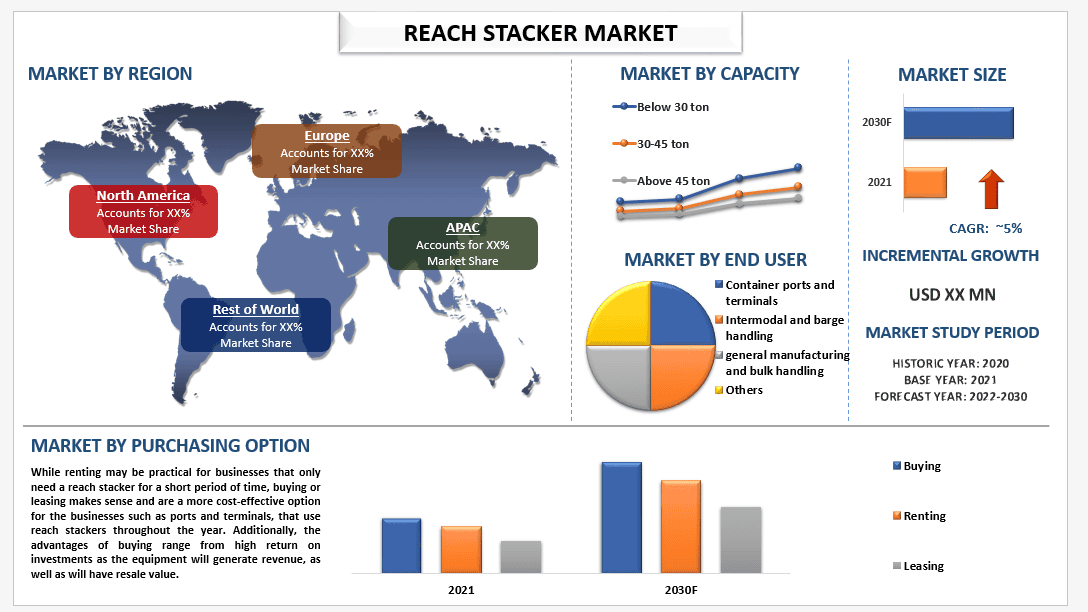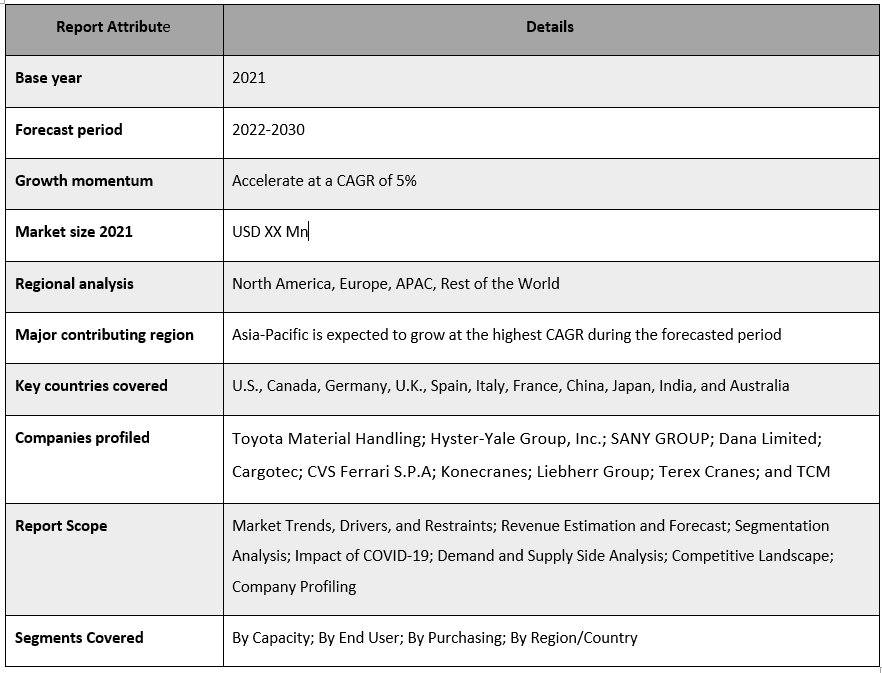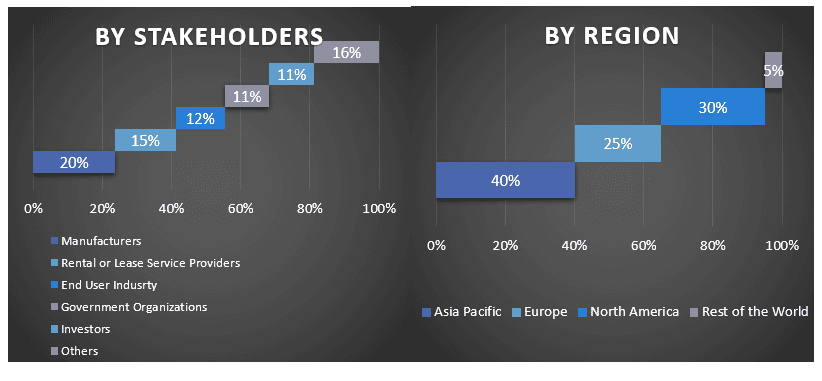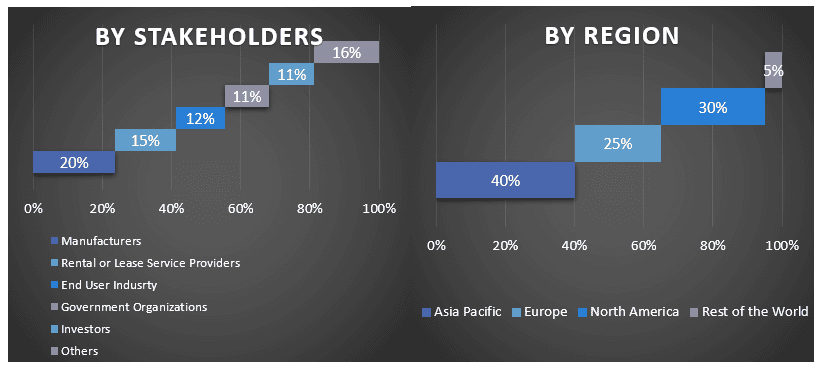Emphasis on Capacity (Below 30 Tons, 30-45 Tons, and Above 45 Tons), Application (Container Ports and Terminals, Intermodal and Barge Handling, General Manufacturing and Bulk Handling, and Others), Purchasing Option (Buying, Renting, and Leasing), and Region/Country.

The reach stacker market is expected to grow at a steady CAGR of around 5% during the forecast period 2023-2030.
The reach stacker is a material-handling vehicle that transports intermodal containers. They provide short-distance transport for containers transferred to and from fleets, vessels, or railcars at ports, railyards, or other storage terminals. The market of reach stackers is mainly driven owing to increasing investments in ports and terminals as port activities have multiplying effects within an economy. Furthermore, though the ports are increasing, but not at the rate with which cargo is rising, and the shortage of space in the existing urban ports demands to increase the space productivity within the ports and that’s where reach stacker plays an important role in increasing the efficiency, and productivity of the port. Additionally, electrification of material handling equipment is also playing a major role in raising the demand for reach stackers, where companies are replacing their old polluting material handling equipment with new energy vehicles which do not produce any exhaust fumes, have easier and quicker refueling, produces less noise, are low maintenance, and are equipped with new age connected technologies which are essential for efficient cargo management as well as produces a better and safe working environment for the workers, due to less noise and air pollution. These trends can also be seen in the new product launches and acquisitions of equipment that are happening in the industry. For instance, on May 2023, Kalmar, part of Cargotec, officially handed over its first fully electric reach stacker to long-term partner Cabooter Group following a six-month testing period. Cabooter Group is already benefiting from lower fuel costs and reduced emissions thanks to five Kalmar Eco reach stackers deployed at Venlo and at the company’s Kaldenkirchen terminal in Germany.
Some of the major players operating in the market include Toyota Material Handling; Hyster-Yale Group, Inc.; SANY GROUP; Dana Limited; Cargotec; CVS Ferrari S.P.A; Konecranes; Liebherr Group; Terex Cranes; and TCM
Insights Presented in the Report
Based on capacity type, the market is segmented into below 30 tons, 30-45 tons, and above 45 tons. The 30-45 ton reach stackers hold a significant market share owing to their high demand in the ports and terminal industry, where they are used for container stacking. The 30-45ton reach stackers are used the most as they cover a wide variety of container cargo. Moreover, they offer great maneuverability and lifting capacity leading to efficient and cost-effective operations. Furthermore, they offer versatility in handling a wide variety of cargo instead of just containers, as they can be equipped with a variety of attachments such as forks, spreaders, etc, and are widely in use in different industries for various loading and unloading operations.
Reach Stacker Market Report Coverage

“Asia Pacific dominated the reach stacker market in 2021.”
Asia’s ports infrastructure sector is among the largest and fastest-growing in the world, with increasing trade flows and economic development driving the need for larger and more efficient port facilities. For emerging markets in Asia, ports are becoming an essential catalyst for economic growth. Furthermore, The Asia Pacific region is known for its robust international trade activities, including exports and imports. With the rise in global trade, there is a growing demand for efficient and reliable handling of cargo at ports and logistics centers. Reach stackers play a crucial role in container handling and have become essential equipment in these operations. Moreover, The Asia Pacific region is witnessing a surge in containerization as businesses realize the benefits of standardized containerized cargo. Reach stackers are indispensable in handling containers efficiently, making them vital equipment for port and logistics operations. Additionally, As the demand for handling larger volumes of cargo increases, there is a growing emphasis on automation and efficiency in port and logistics operations. Reach stackers with advanced features like automated lifting, positioning, and container weighing capabilities are increasingly sought after to optimize productivity and reduce operational costs. And these are the factors that are contributing to the growth of the reach stacker market in the Asia Pacific region. For instance, on March 2022, Third Wave Automation (TWA), a company that provides autonomous solutions for the materials handling industry, and CLARK Material Handling Company, a global manufacturer of forklift trucks and aftermarket parts, announces its partnership and release of a newly automated reach truck in the spring of 2023, the TWA Reach. The TWA Reach is a fully automated reach truck solution capable of operating in 10ft + aisles up to a height of 366 inches in base configurations. The automated truck works alongside warehouse teams and utilizes TWA’s Core automation technology and Collaborative Autonomy Platform to enable remote operation, remote assistance, fleet management, and continuous learning capabilities.
Reasons to buy this report:
Customization Options:
The global reach stacker market can further be customized as per the requirement or any other market segment. Besides this, UMI understands that you may have your own business needs, hence feel free to connect with us to get a report that completely suits your requirements.
1. Market Introduction
2. Research Methodology Or Assumption
3. Market Synopsis
4. Executive Summary
5. Global Reach Stacker Market Covid-19 Impact
6. Global Reach Stacker Market Revenue, 2020-2030f
7. Market Insights By Capacity
8. Market Insights By End User
9. Market Insights By Purchasing Option
10. Market Insights By Region
11. Reach Stacker Market Dynamics
12. Reach Stacker Market Opportunities
13. Reach Stacker Market Trends
14. Demand And Supply-side Analysis
15. Value Chain Analysis
16. Case Study
17. Strategic Insights
18. Competitive Scenario
19. Company Profiled
20. Disclaimer
Research Methodology for the Reach Stacker Market Analysis (2022-2030)
Analyzing the historical market, estimating the current market, and forecasting the future market of the global reach stacker market were the three major steps undertaken to create and analyze the adoption of the reach stacker in major regions globally. Exhaustive secondary research was conducted to collect the historical market numbers and estimate the current market size. Secondly, to validate these insights, numerous findings and assumptions were taken into consideration. Moreover, exhaustive primary interviews were also conducted, with industry experts across the value chain of the global reach stacker market. Post assumption and validation of market numbers through primary interviews, we employed a top-down/bottom-up approach to forecasting the complete market size. Thereafter, market breakdown and data triangulation methods were adopted to estimate and analyze the market size of segments and sub-segments of the industry pertains to. Detailed methodology is explained below:
Analysis of Historical Market Size
Step 1: In-Depth Study of Secondary Sources:
Detail secondary study was conducted to obtain the historical market size of the reach stacker market through company internal sources such as annual reports & financial statements, performance presentations, press releases, etc., and external sources including journals, news & articles, government publications, competitor publications, sector reports, third-party database, and other credible publications.
Step 2: Market Segmentation:
After obtaining the historical market size of the reach stacker market, we conducted a detailed secondary analysis to gather historical market insights and share for different segments & sub-segments for major regions. Major segments are included in the report by capacity, by end-user, and by purchasing option. Further country-level analyses were conducted to evaluate the overall adoption of testing models in that region.
Step 3: Factor Analysis:
After acquiring the historical market size of different segments and sub-segments, we conducted a detailed factor analysis to estimate the current market size of the reach stacker market. Further, we conducted factor analysis using dependent and independent variables such as capacity, by end-user, and by purchasing option of the reach stacker market. A thorough analysis was conducted for demand and supply-side scenarios considering top partnerships, mergers and acquisitions, business expansion, and product launches in the reach stacker market sector across the globe.
Current Market Size Estimate & Forecast
Current Market Sizing: Based on actionable insights from the above 3 steps, we arrived at the current market size, key players in the global reach stacker market, and market shares of the segments. All the required percentage shares split and market breakdowns were determined using the above-mentioned secondary approach and were verified through primary interviews.
Estimation & Forecasting: For market estimation and forecast, weights were assigned to different factors including drivers & trends, restraints, and opportunities available for the stakeholders. After analyzing these factors, relevant forecasting techniques i.e., the top-down/bottom-up approach were applied to arrive at the market forecast for 2030 for different segments and sub-segments across the major markets globally. The research methodology adopted to estimate the market size encompasses:
Market Size and Share Validation
Primary Research: In-depth interviews were conducted with the Key Opinion Leaders (KOLs) including Top Level Executives (CXO/VPs, Sales Head, Marketing Head, Operational Head, Regional Head, Country Head, etc.) across major regions. Primary research findings were then summarized, and statistical analysis was performed to prove the stated hypothesis. Inputs from primary research were consolidated with secondary findings, hence turning information into actionable insights.
Split of Primary Participants in Different Regions

Market Engineering
The data triangulation technique was employed to complete the overall market estimation and to arrive at precise statistical numbers for each segment and sub-segment of the global reach stacker market. data was split into several segments & sub-segments post studying various parameters and trends in the areas of capacity, by end-user, and by purchasing option in the global reach stacker market.
The main objective of the Global Reach Stacker Market Study
The current & future market trends of the global reach stacker market were pinpointed in the study. Investors can gain strategic insights to base their discretion for investments on the qualitative and quantitative analysis performed in the study. Current and future market trends determined the overall attractiveness of the market at a regional level, providing a platform for the industrial participant to exploit the untapped market to benefit from a first-mover advantage. Other quantitative goals of the studies include:

Customers who bought this item also bought